
DVD DIGITAL CINEMA SYSTEM
Consists of
SOUND
VOLUME
DVD DIGITAL CINEMA SYSTEM
STANDBY
STANDBY/ON
SOURCE
INSTRUCTIONS
[B]

DVD DIGITAL CINEMA SYSTEM
Consists of
SOUND
VOLUME
DVD DIGITAL CINEMA SYSTEM
STANDBY
STANDBY/ON
SOURCE
INSTRUCTIONS
[B]
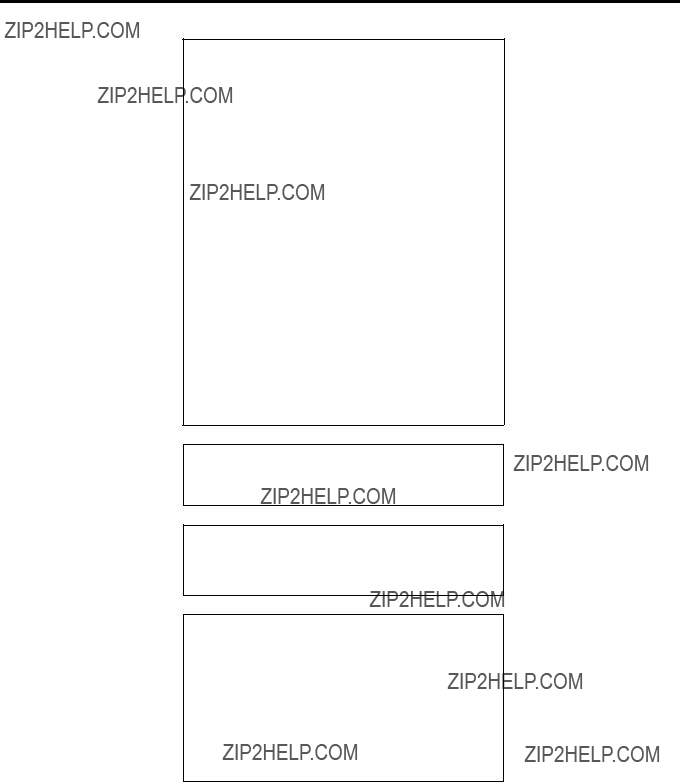
Warnings, Cautions and Others
IMPORTANT for the U.K.
DO NOT cut off the mains plug from this equipment. If the plug fitted is not suitable for the power points in your home or the cable is too short to reach a power point, then obtain an appropriate safety approved extension lead or consult your dealer.
BE SURE to replace the fuse only with an identical approved type, as originally fitted.
If nonetheless the mains plug is cut off ensure to remove the fuse and dispose of the plug immediately, to avoid a possible shock hazard by inadvertent connection to the mains supply.
If this product is not supplied fitted with a mains plug then follow the instructions given below:
IMPORTANT.
DO NOT make any connection to the terminal which is marked with the letter E or by the safety earth symbol or coloured green or
The wires in the mains lead on this product are coloured in accordance with the following code:
Blue : Neutral
Brown : Live
As these colours may not correspond with the coloured markings identifying the terminals in your plug proceed as follows:
The wire which is coloured blue must be connected to the terminal which is marked with the letter N or coloured black.
The wire which is coloured brown must be connected to the terminal which is marked with the letter L or coloured red.
IF IN DOUBT - CONSULT A COMPETENT ELECTRICIAN.
CAUTION
To reduce the risk of electrical shocks, fire, etc.:
1.Do not remove screws, covers or cabinet.
2.Do not expose this appliance to rain or moisture.
Caution  switch!
switch!
Disconnect the mains plug to shut the power off completely. The STANDBY/ON  button in any position does not discon- nect the mains line.
button in any position does not discon- nect the mains line.
The power can be remote controlled.
CAUTION
???Do not block the ventilation openings or holes.
(If the ventilation openings or holes are blocked by a newspa- per or cloth, etc., the heat may not be able to get out.)
???Do not place any naked flame sources, such as lighted candles, on the apparatus.
???When discarding batteries, environmental problems must be considered and local rules or laws governing the disposal of these batteries must be followed strictly.
???Do not expose this apparatus to rain, moisture, dripping or splashing and that no objects filled with liquids, such as vases, shall be placed on the apparatus.
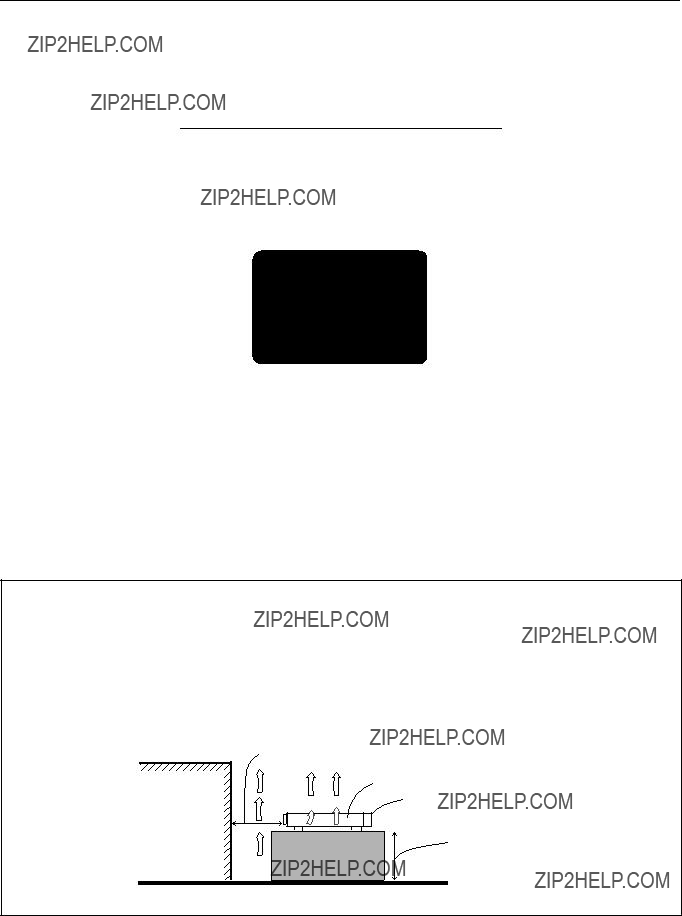
IMPORTANT FOR LASER PRODUCTS
1.CLASS 1 LASER PRODUCT
2.CAUTION: Do not open the top cover. There are no user serviceable parts inside the Unit; leave all servicing to qualified service personnel.
3.CAUTION: Visible and invisible laser radiation when open and interlock failed or defeated. Avoid direct exposure to beam.
4.REPRODUCTION OF LABEL: CAUTION LABEL, PLACED
INSIDE THE UNIT.
Caution: Proper Ventilation
To avoid risk of electric shock and fire and to protect from damage.
Locate the apparatus as follows:
In addition, maintain the best possible air circulation as illustrated.

SAFETY INSTRUCTIONS
???SOME DOS AND DON???TS ON THE SAFE USE OF EQUIPMENT???
This equipment has been designed and manufactured to meet international safety standards but, like any electrical equipment, care must be taken if you are to obtain the best results and safety is to be assured.
Do read the operating instructions before you attempt to use the equipment.
Do ensure that all electrical connections (including the mains plug, extension leads and interconnections between pieces of equipment) are properly made and in accordance with the manufacturer???s instructions. Switch off and withdraw the mains plug when making or changing connections.
Do consult your dealer if you are ever in doubt about the installation, operation or safety of your equipment.
Do be careful with glass panels or doors on equipment.
DON???T continue to operate the equipment if you are in any doubt about it working normally, or if it is damaged in any
DON???T remove any fixed cover as this may expose dangerous voltages.
DON???T leave equipment switched on when it is unattended unless it is specifically stated that it is designed for unattended operation or has a standby mode.
Switch off using the switch on the equipment and make sure that your family know how to do this.
Special arrangements may need to be made for infirm or handicapped people.
DON???T use equipment such as personal stereos or radios so that you are distracted from the requirements of traffic safety. It is illegal to watch television whilst driving.
DON???T listen to headphones at high volume as such use can permanently damage your hearing.
DON???T obstruct the ventilation of the equipment, for example with curtains or soft furnishings.
Overheating will cause damage and shorten the life of the equipment.
DON???T use makeshift stands and NEVER fix legs with wood screws ??? to ensure complete safety always fit the manufacturer???s approved stand or legs with the fixings provided according to the instructions.
DON???T allow electrical equipment to be exposed to rain or moisture.
ABOVE ALL
???NEVER let anyone, especially children, push anything into holes, slots or any other opening in the case
???NEVER guess or take chances with electrical equipment of any kind ??? it is better to be safe than sorry!

Table of Contents
1
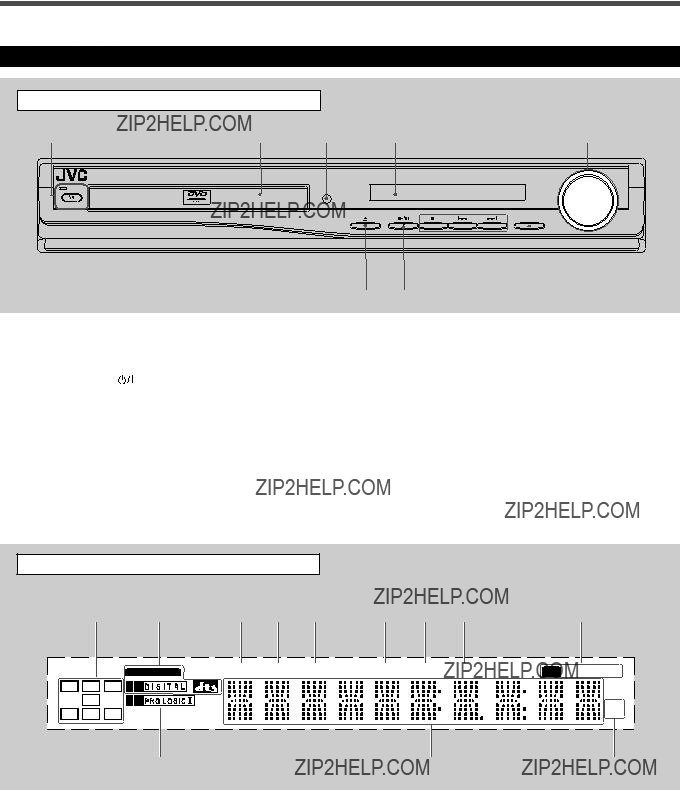
Parts Identification
Center Unit
Front Panel
VOLUME
DVD DIGITAL CINEMA SYSTEM
STANDBY
STANDBY/ON
SOURCE
???Pressing this button also turns on the power and changes the source to the DVD/CD.
Display
See pages in the parentheses for details.
Display
1Audio channel indicators
???Indicates audio channels currently being reproduced. 2 Digital signal indicators (11, 17, 18)
???LINEAR PCM, DOLBY DIGITAL, and DTS.
3TITLE indicator (11)
???Indicates the current title number with main display. 4 PBC (Play Back Control) indicator
???Goes on when the PBC function is activated.
5CHAP (chapter) indicator (11)
??? Indicates the current chapter number with main display.
6 PRGM (program) indicator (33)
7 RDS indicator (34)
8 RT indicator (34)
9 Tuner mode indicators (13, 32, 33)
??? ST (stereo) and TUNED
p Dolby PRO LOGIC II indicator (11, 17, 18) q Main display
wFrequency unit indicators
???kHz (for AM band station) and MHz (for FM band station)
2

Remote Control
4??? Number buttons
???MEMORY button (33)
???CANCEL button
5Source selecting buttons
??? DVD, FM/AM, AUX (10, 13, 14)
k??? 1 and ?? buttons
???TUNING UP and DOWN buttons (13, 32) l ZOOM button (27)
/ ANGLE button (23)
z ??? REPEAT button (26, 31)
???FM MODE button (33)
xPL II button (11, 18)
3
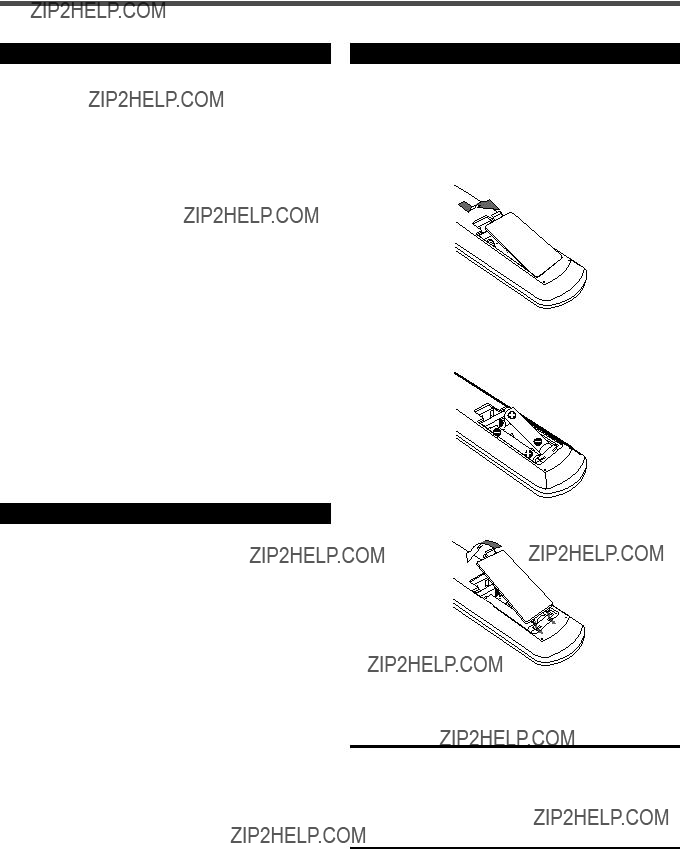
Getting Started
General Precautions
???DO NOT insert any metal object into the center unit.
???DO NOT disassemble the center unit or remove screws, covers, or cabinet.
???DO NOT expose the center unit to rain or moisture.
Locations
???Install the center unit in a location that is level and protected from moisture.
???The temperature around the center unit must be between 5??C and 35??C.
???Make sure there is good ventilation around the center unit. Poor ventilation could cause overheating and damage the center unit.
Handling the center unit
???DO NOT touch the power cord with wet hands.
???DO NOT pull on the power cord to unplug the cord. When unplugging the cord, always grasp the plug so as not to damage the cord.
???Keep the power cord away from the connecting cords and the antenna. The power cord may cause noise or screen interference. It is recommended to use a coaxial cable for antenna connection, since it is
???When a power failure occurs, or when you unplug the power cord, the preset settings such as preset FM/AM channels and sound adjustments may be erased in a few days.
Before using the remote control, put two supplied batteries first.
???When using the remote control, aim the remote control directly at the remote sensor on the center unit.
1.On the back of the remote control, remove the battery cover.
2.Insert batteries. Make sure to match the polarity:
(+) to (+) and
Checking the Supplied Accessories
Check to be sure you have all of the following supplied accessories. The number in the parentheses indicates the quantity of the pieces supplied.
???Remote Control (1)
???Batteries (2)
???AM Loop Antenna (1)
???FM Antenna (1)
???Video Cord (1)
???Speaker Cords
6 m (4): For subwoofer
For the satellite speakers on the following positions:
left front, right front, and center
10 m (2): For the satellite speakers on left and right rear positions
If anything is missing, contact your dealer immediately.
3. Replace the cover.
If the range or effectiveness of the remote control decreases, replace the batteries. Use two
CAUTION:
Follow these precautions to avoid leaking or cracking cells:
???Place batteries in the remote control so they match the polarity: (+) to (+) and
???Use the correct type of batteries. Batteries that look similar may differ in voltage.
???Always replace both batteries at the same time.
???Do not expose batteries to heat or flame.
4
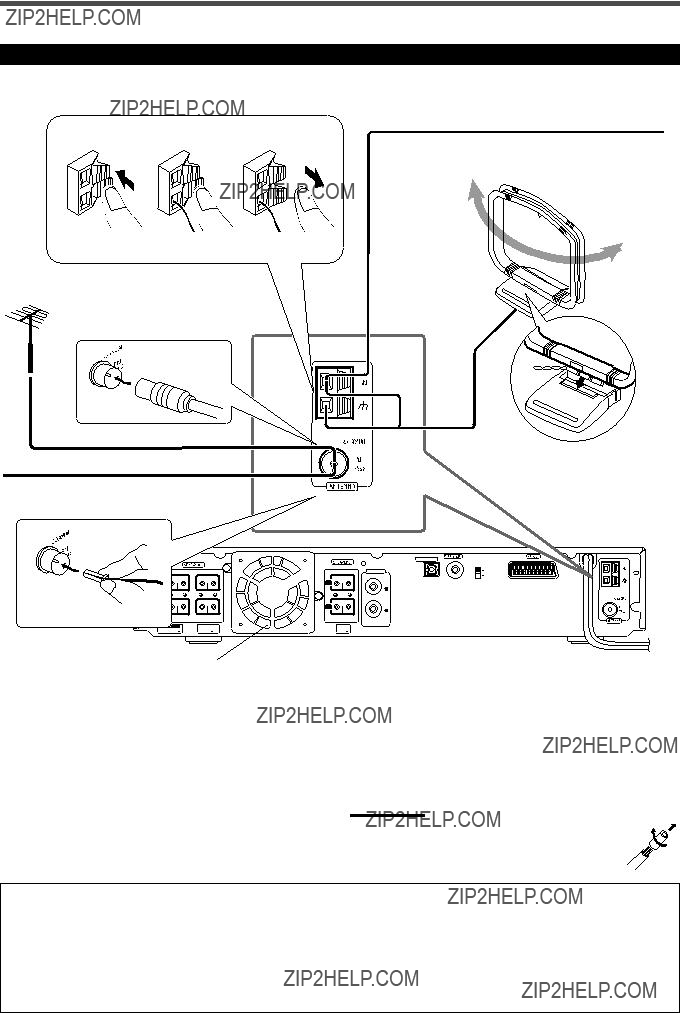
Connecting the FM and AM Antennas
If AM reception is poor, connect single
AM Loop antenna (supplied)
If FM reception is poor, connect outdoor FM antenna (not supplied).
FM antenna (supplied)
Snap the tabs on the loop into the slots of the base to assemble the AM Loop antenna.
COMPOSITE
FM antenna connection
Connect the supplied FM antenna to the COAXIAL FM 75 ??? terminal as temporary measure.
Extend the supplied FM antenna horizontally.
???If reception is poor, connect an outdoor antenna. Before attaching a 75 ??? coaxial cable (with a standard type connector), disconnect
the supplied FM antenna.
AM antenna connection
Connect the supplied AM Loop antenna to the AM and H terminals. Turn the loop until you have the best reception.
???If reception is poor, connect an outdoor single
Notes:
If the AM Loop antenna wire is covered with vinyl, remove
the vinyl by twisting it as shown in the diagram.
About the cooling fan
A cooling fan is mounted on the rear panel of the center unit to prevent abnormal temperature inside the center unit, thus assuring normal operation of the unit. The cooling fan automatically starts rotating to intake external cool air when the internal temperature goes up.
For safety, observe the following carefully.
???Make sure there is good ventilation around the center unit. Poor ventilation could overheat and damage the center unit.
???DO NOT block the cooling fan and the ventilation openings or holes. (If they are blocked by a newspaper or cloth, etc., the heat may not be able to get out.)
???DO NOT touch the speaker cords to the cooling fan.
5

Getting Started
Speaker Layout Diagram
Center unit
Center position
To the speaker on left front (White connector)
6

Connecting the Speakers
Connect the satellite speakers and subwoofer to the terminals on the rear panel using speaker cords supplied.
The ends of the speaker cords are colored to indicate the terminals to be connected.
CAUTION:
Use speakers with the SPEAKER IMPEDANCE indicated by the speaker terminals.
Connecting speaker cords to the speakers
???Connect the cord with a gray tube to the red (+) terminal, and the cord with a black tube to the black
???You can use the satellite speakers interchangeably for any position except for subwoofer. Make sure not to connect the subwoofer terminal and the satellite speaker.
1Press and hold the terminal clamp.
2Insert the speaker cord.
3Release the finger from the clamp.
Notes:
??? If the speaker cord is covered with vinyl, remove the vinyl by twisting it as shown in the diagram.
??? Make sure the core wire of speaker cords do not expose to out of the terminals. This could cause
Connecting speaker cords to the center unit
With the Side marked ?? and ?? upward.
Speaker Connector
When setting the speakers
To obtain the best possible sound from this system, you need to place all the speakers except the subwoofer at the same distance from the listening position with each front faced toward the listener. Since bass sound is
Subwoofer
If your speakers cannot be placed at the same distance from the listening position
You can adjust the delay time of the center speaker and rear speakers. For
Notes:
You can change the phase of subwoofer sounds by connecting the speaker cords to the terminals
You may get more effective bass sounds by changing the phase.
CAUTIONS:
???When attaching the satellite speakers on the wall, have them attached to the wall by a qualified person.
DO NOT attach the satellite speakers on the wall by yourself to avoid an unexpected damage of their falling from the wall, caused by incorrect attachment or weakness in the wall.
???Care is required in selecting a location for attaching speakers to the wall. Injury to personnel, or damage to equipment, may result if the speakers are attached in a location which interferes with daily activities.
Insert the speaker connectors to the speaker terminals on the rear panel.
??? Make sure to match the color of the connector and the terminal.
7
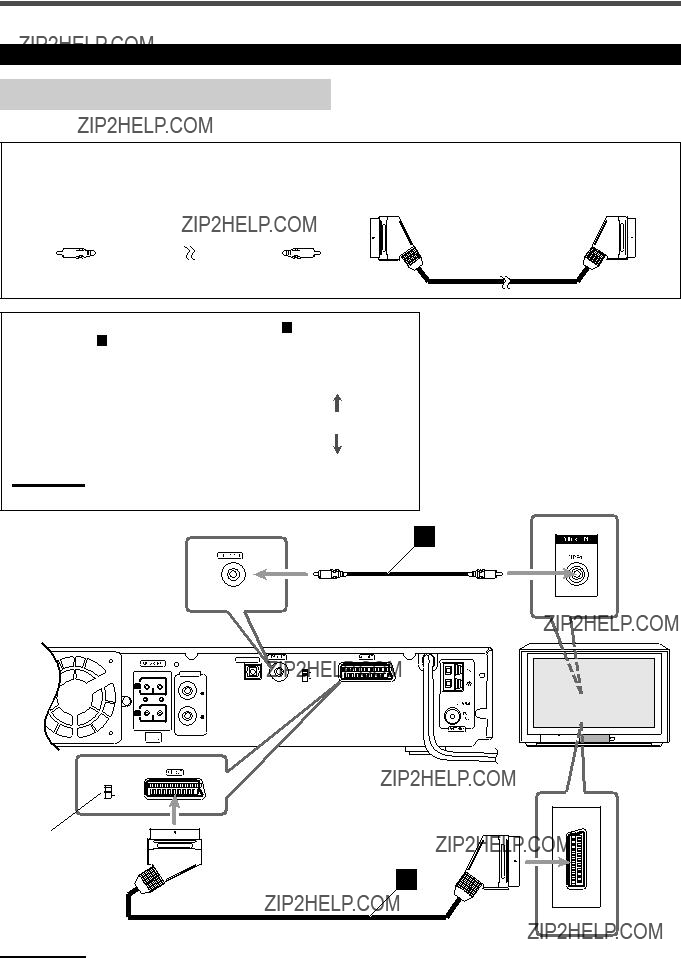
Getting Started
Connecting Audio/Video Component
Turn the power off to all components before connections.
TV connection
The SCART cable is not supplied with this system.
Use the cable supplied with the other component or purchase one at an electric appliance store.
You can connect TV with either the composite video cord ( A ) or the SCART cable ( B ).
Notes:
The AV OUT on this unit is not compatible with the
A
1
TV
COMPOSITE
L
R
REAR
AUX
REAR
MIN 6

 RGB
RGB
COMPOSITE
RGB/COMPOSITE selector
B
Notes:
The SCART terminal on the rear panel is indicated as ???AV OUT.??? However, this terminal is designed as video output. So, no audio signals are emitted through this terminal.
8

Audio component connection
Connect other components to the center unit with the audio cord.
Use the cord supplied with the other component or purchase one at an electric appliance store.
AOptical digital cord (not supplied)
BAudio cord (not supplied)
Illustrations of the input/output terminals below are typical examples.
When you connect other components, refer also to their manuals since the terminal name actually printed on the rear vary among the components.
If you connect a
DBS Tuner
DIGITAL IN
OPTICAL
Before connecting an optical digital cord, unplug the
protective plug.
DIGITAL
OPTICAL OUT
MD Recorder
A
DBS Tuner
MD Recorder
Cassette Deck
AUDIO
AUDIO IN
B
AUX
RIGHT
VCR
OUT
TV
9

Basic Disc Operations
This manual mainly explains operations using the buttons on the remote control. You can also use the buttons on the center unit if they have the similar names (or marks) as those on the remote control.
If operations using the center unit are different from those using the remote control, they are then explained.
1 Turn On the Power
Before turning on the system, turn on your TV and select the correct video input. (See the manual supplied with your TV.)
TV 
2 DVD
TV/VIDEO
5 AUDIO VOL
+/???
DOWN
DVD CINEMA SYSTEM
For
The source changes to the DVD/CD player.
On the front panel:
Press SOURCE repeatedly until ???DVD/CD??? appears SOURCE on the display.
3 Load a Disc
On the front panel ONLY:
Press 0 to open the disc tray, then place a disc correctly with its label side up (for
CORRECT INCORRECT
???When using an 8 cm disc, place it on the inner circle of the disc tray.
???Continued use of irregular shape discs
???DO NOT use the disc stabilizer.
10
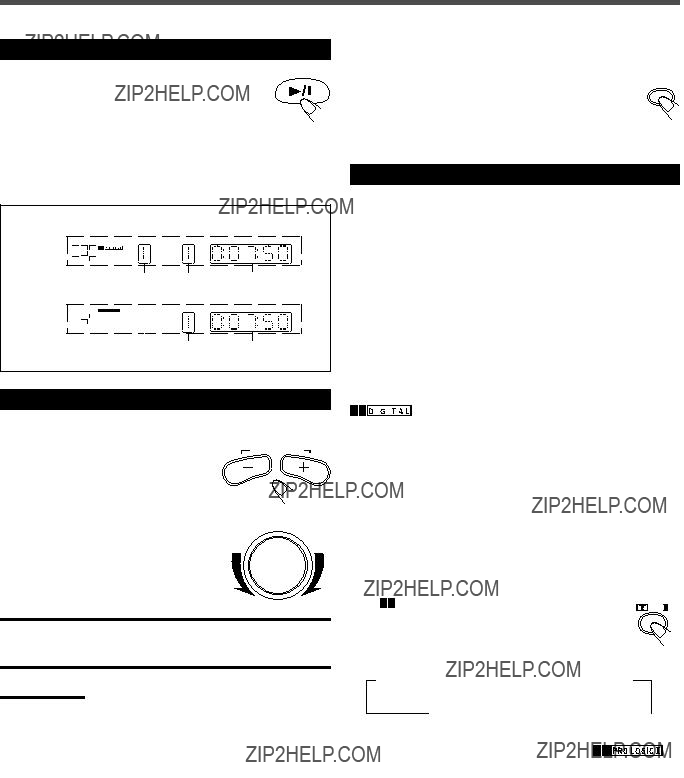
4 Start Playback
Press 3/8.
The disc tray closes. ???LOADING??? appears on the display for a while.
???You can also start playback by closing the disc tray using 0 on the front panel.
???Some discs show menus on the TV screen after you press 3/8. See ???Disc
Playback Information on the display
TITLE CHAP
Title No. Chapter No. Elapsed playing time
LINEAR PCM
Track No. Elapsed playing time
To turn off the sounds temporarily
6Activate Surround
You can enjoy two kinds of
Digital Multichannel
and DTS Digital Surround
Dolby Digital or DTS Digital Surround takes effect only when you play back a disc encoded with these signals.
To activate Dolby Digital or DTS Digital Surround
When a Dolby Digital or DTS
5 Adjust the Volume
From the remote control:
To increase the volume,
press and hold AUDIO VOL +.
To decrease the volume,
press and hold AUDIO VOL
On the front panel:
To increase the volume,
turn VOLUME control clockwise.
To decrease the volume,
turn VOLUME control counterclockwise.
CAUTION:
AUDIOVOL
VOLUME
system detects it and starts playing the disc automatically with Multichannel Surround activated.
???For
Dolby Pro Logic II
To activate Pro Logic II modes
You can use these modes when playing back any
The current Pro Logic II mode appears on the display for
Always set the volume to the minimum before starting any source. If the volume is set at its high level, the sudden blast of sound energy can permanently damage your hearing and/or ruin your speakers.
Notes:
???By pressing AUDIO VOL + or ??? repeatedly, you can adjust the volume level step by step.
???The volume level can be adjusted within 51 steps??? ???MIN (minimum),??? ???1??? to ???49,??? and ???MAX (maximum).???
???If you have turned off the unit with the volume level set at more than level ???25,??? the volume level will be automatically set at level ???25??? next time you turn on the unit.
a while.
???Each time you press the button, Pro Logic II mode changes as follows:
 PLII MUSIC
PLII MUSIC  PLII MOVIE
PLII MOVIE  PLII MATRIX
PLII MATRIX
STEREO PRO LOGIC
PRO LOGIC (PL II OFF)
(PL II OFF)
???When Dolby Pro Logic II mode is activated, the indicator lights up on the display.
???For
11
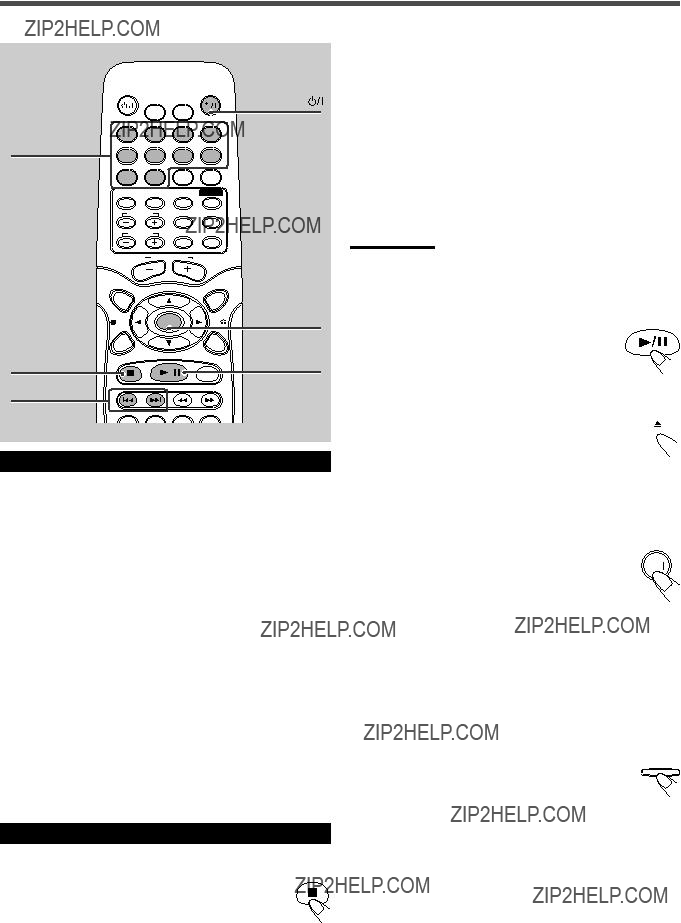
Basic Disc Operations
Moving to Another Chapter/Track/File
To go to another chapter (for DVD), track (for
CD and VCD), or file (for MP3 and JPEG)
Press ?? or 4 repeatedly during playback.
?????: Skips to the beginning of the next or succeeding chapter, track, or file.
???4: Goes back to the beginning of the current or previous chapter, track, or file.
???You can skip some 5 minutes forward/back with pressing ??/ 4 while you are playing back a VCD track which is longer than some 15 minutes.
To go to another track (only possible on a CD and VCD without PBC) directly using the number buttons
Pressing the number buttons before or during play allows you to start playing the track number you want. If your TV is turned on, ???SELECT XX??? (XX is the selected track number) appears on the TV screen.
???To select number 1 to 9, press the corresponding number button, then press ENTER.
???To select number 15, press 1, 5, then press ENTER.
???To select number 23, press 2, 3, then press ENTER.
Stopping Playback
To stop playback
Press 7.
Playback stops.
???This system can memorize the end point even when you press 7 once when playing back a DVD (???PRESS PLAY TO CONTINUE??? appears on the TV screen). When you start playback again by pressing 3/8, playback begins from where it has been
Press 7 again, then press 3/8 to play back the DVD from the beginning.
???When you start playback an MP3 or a JPEG file again by pressing
3/8, playback begins from the beginning of the file which had been played before you stopped playback.
???For
Notes:
The TV screen gets dark to save the screen when you leave the system for a few minutes without any operations after stopping playback. Press some button to restore the screen brightness.
To stop playback for a moment
Press 3/8.
While pausing, the elapsed playing time flashes on the display.
??? To resume play, press 3/8again.
To remove the disc
Press 0.
???OPEN??? appears on the display and the disc tray comes out. 
To close the disc tray, press 0 again.
???If you do not press the button, the disc tray closes automatically in a few minutes.
To turn off the power (into standby)
Press AUDIO  (or STANDBY/ON
(or STANDBY/ON  on the front AUDIO panel).
on the front AUDIO panel). 
The STANDBY lamp lights up.
???If you press AUDIO  (or STANDBY/ON
(or STANDBY/ON  on the
on the
front panel) while the disc tray is kept open, the disc tray closes automatically, then the system is turned off.
???A small amount of power is consumed even in standby mode. To turn the power off completely, unplug the AC power cord.
To prohibit disc ejection
On the front panel ONLY:
1 Press STANDBY/ON  (or AUDIO
(or AUDIO  on the remote control) to turn off the power.
on the remote control) to turn off the power.
The STANDBY lamp lights up.
2 Press and hold SOURCE for more than 5 seconds. SOURCE
???LOCKED??? appears on the display for a moment and the disc tray is locked.
To unlock the disc tray, turn off the power, then press and hold SOURCE for more than 5 seconds.
???UNLOCKED??? appears on the display for a moment and the disc tray is unlocked.
???You can neither lock nor unlock the disc tray while the system is turned on.
12

Basic Tuner Operations
On the front panel:
Press SOURCE repeatedly until the desired band (FM SOURCE or AM) appears on the display. 
The last received station of the selected band is tuned into.
??? Each time you press the button, the source changes as follows:
 DVD/CD
DVD/CD  DIGITAL IN
DIGITAL IN
AM  FM
FM  AUX
AUX 
3 Adjust the Volume
From the remote control:
To increase the volume,
press and hold AUDIO VOL +.
To decrease the volume,
press and hold AUDIO VOL
On the front panel:
To increase the volume,
turn VOLUME control clockwise.
To decrease the volume,
turn VOLUME control counterclockwise.
 AUDIOVOL
AUDIOVOL 
VOLUME
For
1 Turn On the Power
Press AUDIO  (or STANDBY/ON
(or STANDBY/ON  on the front AUDIO panel).
on the front AUDIO panel).
The STANDBY lamp goes off.
The source indication selected previously appears on the display.
2 Select the Band
From the remote control:
The last received station of the selected band is tuned in.
???Each time you press the button, the band alternates between FM and AM.
4 Tune into a Station
From the remote control:
Press and hold TUNING UP or DOWN until the DOWN  the display.
the display.
The system starts searching for a station.
???When a station of sufficient signal strength is tuned in, the system stops searching, and the 

 indicator lights up on the display.
indicator lights up on the display.
On the front panel:
1Press 7 so that ???MANUAL??? appears on the display.
2Press and hold ?? or 4 until the station frequency starts changing continuously on the display.
The system starts searching for a station.
Notes:
???When an FM stereo program is received, the indicator also lights up.
indicator also lights up.
???When you press the button repeatedly, the frequency changes step by step.
To turn off the power (into standby)
Press AUDIO  (or STANDBY/ON
(or STANDBY/ON  on the front AUDIO panel).
on the front AUDIO panel).
The STANDBY lamp lights up.
???A small amount of power is consumed even in standby mode. To turn the power off completely, unplug the AC power cord.
13

Other Basic Operations
 TV CH
TV CH CONTROL TESTTONE
CONTROL TESTTONE
TV
 TVVOL
TVVOL TV/VIDEO MUTING
TV/VIDEO MUTING
DVD CINEMA SYSTEM
Enjoying Sounds from the External
Component
You can enjoy sounds from the external components connected to the AUDIO IN jacks and the DIGITAL IN terminal on the rear panel of the center unit.
2Start playback on the external component.
???For
Notes:
???When ???DIGITAL IN??? is selected as the source and the Dolby Digital or DTS
For
???Surround Mode Introduction??? on page 17.
???You can enjoy Dolby Pro Logic II mode when you playback any 2- channel sources, either digital or analog.
For
???Surround Mode Introduction??? on page 17.
Turning Off the Power with the Timer
You can fall asleep while listening to
From the remote control ONLY:
???SLEEP??? and the
???Each time you press the button, the
 10
10  20
20  30
30  60
60
(Canceled)
When the
To check or change the time remaining until the
To cancel the Sleep Timer
1 Select AUX or DIGITAL IN as the source.
From the remote control:
 DVD/CD
DVD/CD  DIGITAL IN
DIGITAL IN
AM  FM
FM  AUX
AUX 
DIGITAL IN: select this to enjoy the external component connected to DIGITAL IN terminal.
AUX: select this to enjoy the external component connected to AUDIO IN jacks.
Adjusting the Display Brightness
You can dim the display.
From the remote control ONLY:
???Each time you press the button, the brightness level of the display changes as follows:
 Dim
Dim  Dimmer
Dimmer
Canceled
(Normal Display)
14
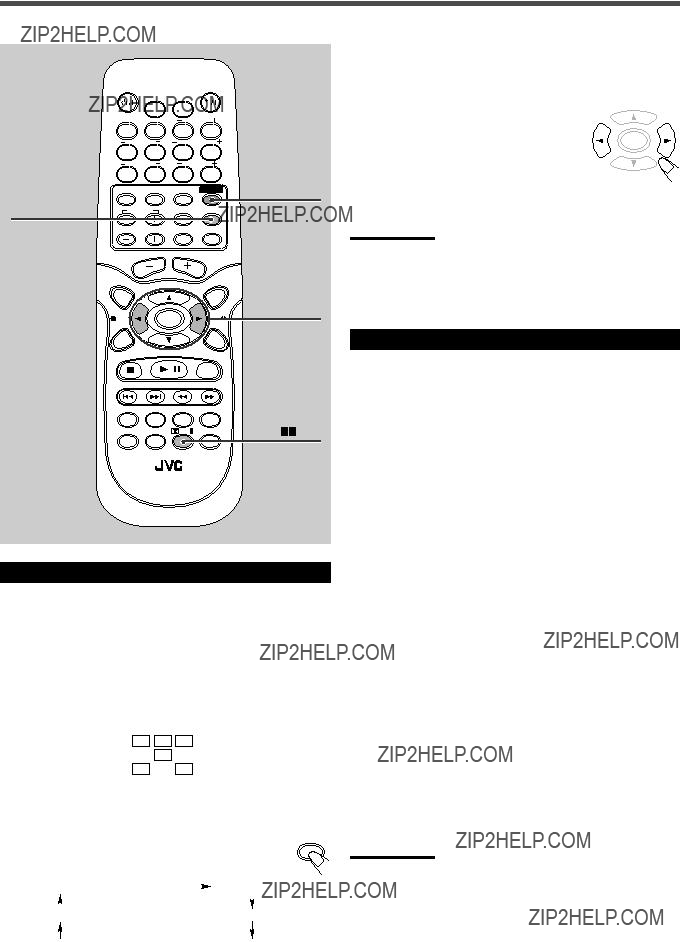
Creating Realistic Sound Fields
 TVVOL
TVVOL TV/VIDEO MUTING
TV/VIDEO MUTING
 AUDIOVOL
AUDIOVOL
3/2
DVD CINEMA SYSTEM
Using the Test Tone
You can check whether each speaker is connected properly.
From the remote control ONLY:
1 Press  PL II repeatedly to activate all the speakers.
PL II repeatedly to activate all the speakers.
The audio channel indicators light up on the display as follows when all the speakers are activated:
L C R
SW
LS RS
???You can also activate all the speakers by loading a digital multichannel disc.
Left rear speaker  Right rear speaker
Right rear speaker
??? To adjust speaker output level
You can adjust the output level of the center speaker, rear speakers, and subwoofer listening to the test tone.
To stop the test tone, press TEST TONE again.
Notes:
???You cannot use this function while playing back a disc. Stop the disc playback to use this function when the source is DVD/CD.
???If no sounds come out of a speaker, check the speaker???s connection (see pages 6 and 7).
???You cannot adjust the output level of rear speakers separately. See
???Adjusting the Sound??? below to adjust the balance of rear speakers.
Adjusting the Sound
You can adjust the sound balance and the tone.
It is recommended to turn on your TV and make adjustments from your actual listening point.
You can adjust the following settings:
Notes:
You can also adjust the output level (CEN LEVEL, REAR LEVEL, and
S/W LEVEL) while using the test tone. See ???Using the Test Tone??? on the left column.
15

Creating Realistic Sound Fields
??? Basic sound adjustment procedure
Ex. : To adjust the front speaker balance
From the remote control ONLY:
1Play the disc you want to use for the sound adjustment.
Each time you press the button, the adjustment indication on the TV screen changes as follows:
CEN LEVEL 0dB
REAR LEVEL 0dB
S/W (subwoofer) LEVEL 0dB
BASS 00dB
TREBLE 00dB
*1: No adjustment bar appears on the TV screen when you adjust the delay time. Refer to the display on the center unit to adjust the delay time.
*2:
*3:
There is a time limit in doing the following steps. If the setting is canceled before you finish, press SOUND and start from step 2 again.
3 Press 3 or 2 to adjust the output balance
???You can also adjust the sound setting referring to the display on the center unit. Refer to the display indication when you want to adjust the sound using sources other than discs.
Sound adjustment indication on the display
Ex.: Front balance
L C R
SW
LS RS
Ex.: Center level
L C R
SW
LS RS
Center output level
Ex.: Rear delay time
L C R
SW
LS RS
Rear delay time
4 Repeat steps 2 and 3 to adjust the other items.
??? On delay time adjustment
You can adjust and store the delay time setting for each surround mode. Select the surround mode you want to adjust before starting delay time adjustment.
??? Adjustable range
1 msec increase (or decrease) in delay time corresponds to 30 cm increase (or decrease) in distance.
3: Decreases the left speaker output, or
ENTER
restores the right speaker output.
2: Decreases the right speaker output, or restores the left speaker output.
Ex. : In this case, set
16

Surround Mode Introduction
You can use the following surround to reproduce a realistic sound field.
???Multichannel
???Dolby Pro Logic II modes
??? Dolby Digital and DTS Digital Surround
To enjoy surround effectively, all the speakers need to be connected and activated.
Dolby Digital*
Used to reproduce multichannel sound tracks of the software encoded with Dolby Digital ( ).
).
Dolby Digital encoding method
Since each channel is completely independent from the other channel signals to avoid interference, you can obtain much better sound quality with much stereo and surround effects.
When the system detects Dolby Digital signals, the 





 indicator lights up on the display.
indicator lights up on the display.
DTS Digital Surround**
Used to reproduce multichannel sound tracks of the software encoded with DTS ( or
or  ).
).
DTS Digital Surround is another discrete 5.1 channel digital audio format available on CD, LD, and DVD software.
Compared to Dolby Digital, audio compression rate is relatively low. This fact allows DTS Digital Surround format to add breadth and depth to the reproduced sounds. As a result, DTS Digital Surround features natural, solid and clear sound.
When the system detects DTS signals, the  indicator lights up on the display.
indicator lights up on the display.
??? Dolby Pro Logic II modes
Dolby Pro Logic II*
Dolby Pro Logic II is the multichannel playback format to decode any 2 channel (stereo)
Dolby Pro Logic II enables to reproduce spacious sound from original sound without adding any new sounds and tonal colorations. Dolby Pro Logic II has four
Pro Logic II Music (PLII
Pro Logic II Movie (PLII 



 DOLBY SURROUND . You can enjoy sound field very close to the one created with discrete 5.1 channel sounds.
DOLBY SURROUND . You can enjoy sound field very close to the one created with discrete 5.1 channel sounds.
Pro Logic II Matrix (PLII
of monaural sources.
Pro Logic (PRO
???When one of Dolby Pro Logic II modes is activated, the 





 indicator lights up on the display.
indicator lights up on the display.
*Manufactured under license from Dolby Laboratories. ???Dolby,??? ???Pro Logic,??? and the
**???DTS??? and ???DTS Digital Surround??? are trademarks of Digital Theater Systems, Inc.
17

Creating Realistic Sound Fields
Activating the Surround Mode
You can enjoy Digital Multichannel Surround (Dolby Digital and DTS Digital Surround) and Dolby Pro Logic II.
To activate Digital Multichannel Surround
When you start playback a Dolby Digital or DTS multi channel disc, the system detects it and activate Multichannel Surround automatically.
???When Dolby Digital is detected, the 





 indicator lights up on the display.
indicator lights up on the display.
???When DTS Digital Surround is detected, the  indicator lights up on the display.
indicator lights up on the display.
To activate Dolby Pro Logic II modes
You can use Dolby Pro Logic II when you playback any 2 channel sources, either digital or analog.
The current Pro Logic II mode appears on the display for a while.
???Each time you press the button, Pro Logic II mode changes as follows:
DVD CINEMA SYSTEM
STEREO PRO LOGIC
PRO LOGIC (PL II OFF)
(PL II OFF)
???When one of the Dolby Pro Logic II modes is activated, the 





 indicator lights up on the display.
indicator lights up on the display.
*Some discs have a certain fixed surround mode which cannot be changed.
18

Disc
This system has been designed to play back the following discs: DVD,
???This system can also play back MP3 and JPEG files recorded on
Discs you can play:
???On some DVD or VCD/SVCD discs, their actual operations may be different from what is explained in this manual. This is due to the disc programming and disc structure, but not a malfunction of this system.
???
Note that unfinalized disc cannot be played back.
???The following discs cannot be played back:
???
Playing back these discs will generate noise and damage the speakers.
* Note on Region Code
DVD players and DVD have their own Region Code numbers. This system only can play back DVD whose Region Code numbers include ???2.???
Examples:
If ???
 ??? appears on the TV screen when pressing a button, the
??? appears on the TV screen when pressing a button, the
disc cannot accept an operation you have tried to do, or information required for that operation is not recorded in the disc.
NOTICE : In some cases, without showing ???
 ,??? operations will not be accepted.
,??? operations will not be accepted.
Disc
A DVD consists of Titles, and each title may be divided into some Chapters. (See Example 1.)
For example, if a DVD contains some movies, each movie may have its own title number, and it may be further divided into some chapters.
On the other hand, a VCD/SVCD/CD consists of Tracks. (See Example 2.)
In general, each song has its own track number. (On some discs, each track may also be divided by Indexes.)
When playing back a VCD/SVCD with Playback Control (PBC) function, you can select what to view using the menu shown on the TV screen. (While operating a VCD/SVCD using the menu, some of the functions such as Repeat and Track Search may not work.)
Notes on
???The system can play back
However, they may not be played back depending on their characteristics or recording conditions.
???Before playing back
???Some
???
If a DVD with the inadequate Region Code numbers is loaded, ???REGION ERR??? appears on the display and playback cannot start.
IMPORTANT: Before performing any operations, make sure of
the following....
???Check the connection with the TV.
???Turn on the TV and select the correct input on the TV to view the pictures or
???For DVD playback, you can change the Setup menu setting to your preference. (See pages 39 to 41.)
This product incorporates copyright protection technology that is protected by method claims of certain U.S. patents and other intellectual property rights owned by Macrovision Corporation and other rights owners. Use of this copyright protection technology must be authorized by Macrovision Corporation, and is intended for home and other limited viewing uses only unless otherwise authorized by Macrovision Corporation. Reverse engineering or disassembly is prohibited.
19

Disc Playback
You can only use the remote control for the operations in this ???Disc Playback??? section.
DVD CINEMA SYSTEM
Using the
You can check the following information on a disc while the disc is loaded, and you can use some functions through the
7 Showing the
From the remote control ONLY:
Press ON SCREEN.
??? Each time you press the button, the following
The
??? SVCD
SVCDLR  1/2
1/2  1/4
1/4
The
??? VCD/CD
CD01/12 LR  OFF
OFF  0:00:28
0:00:28
???For basic disc operations such as inserting a disc, starting playback, and moving to another chapters/tracks, see ???Basic Disc Operations??? from pages 10 to 12.
???






 shows which types of disc are supported for the operations explained in each section.
shows which types of disc are supported for the operations explained in each section.
*
*The
VCD icon appears when you play back a VCD.
Some discs contain several audio languages, subtitles, and multi- angle views.
When you find the following marks on the disc or its package, you can select these elements recorded on the disc.
Subtitles are recorded on the disc. The number

 3
3  inside the mark indicates the total number of the recorded subtitles.
inside the mark indicates the total number of the recorded subtitles.
Several audio languages are recorded on the disc.
3The number inside the mark indicates the total number of the recorded audio languages.
3number inside the mark indicates the total number of the recorded
If you cannot find out whether your disc contains these features listed above, you can check it by showing the
Notes:
DVD and SVCD
ON SCREEN.
20
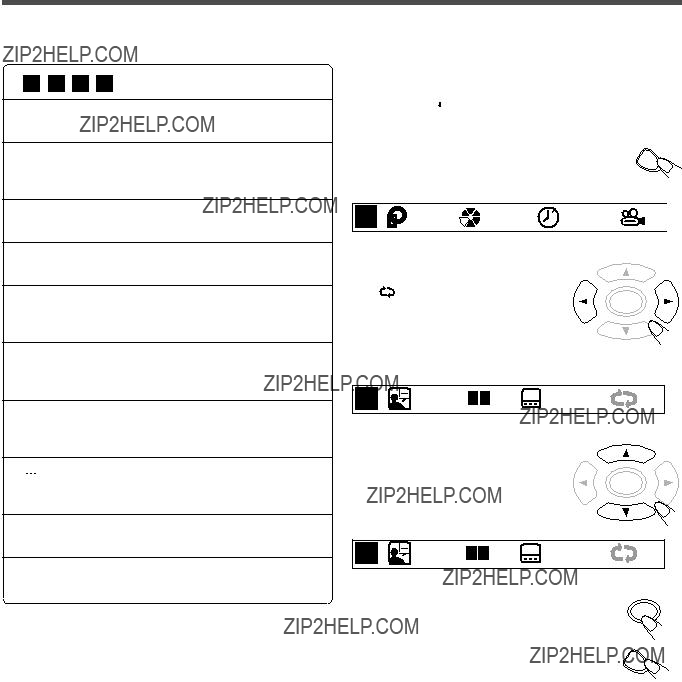
Contents of the
??? DVD SVCD VCD CD : Disc Type icon
???  : Title icon
: Title icon
Shows current title and total number of the titles on the disc.
??? 
 : Chapter icon
: Chapter icon
Shows current chapter and total number of the chapters in the current title.
???  : Track icon
: Track icon
Shows current track and total number of the tracks on the disc.
???  : Time icon
: Time icon
Shows the elapsed playing time or remaining time. See page 23.
???  :
:
Shows current angle and total number of the angle views in the scene. See page 23.
???  : Audio language icon
: Audio language icon
Shows current audio language and total number of languages in the current chapter or track. See page 22.
???  D : Sound signal icon (Ex.: Dolby Digital)
D : Sound signal icon (Ex.: Dolby Digital)
When the sound signal is Dolby Digital or DTS, the sound signal icon appears.
???  : Subtitle language icon
: Subtitle language icon
Shows current subtitle language and total number of languages in the current chapter or track. See page 22.
???  : Sound channel icon
: Sound channel icon
Shows current output sound channel. See page 23.
???  :Repeat mode icon
:Repeat mode icon
Shows current Repeat Play mode. See page 26.
7 Basic operation through the
See the corresponding pages for details of each function.
Ex.: To select ??? TITL (Repeat Title)??? for the repeat mode during DVD play.
TITL (Repeat Title)??? for the repeat mode during DVD play.
1 Press ON SCREEN.
The following
5 Press ON SCREEN.
The
ON SCREEN
21
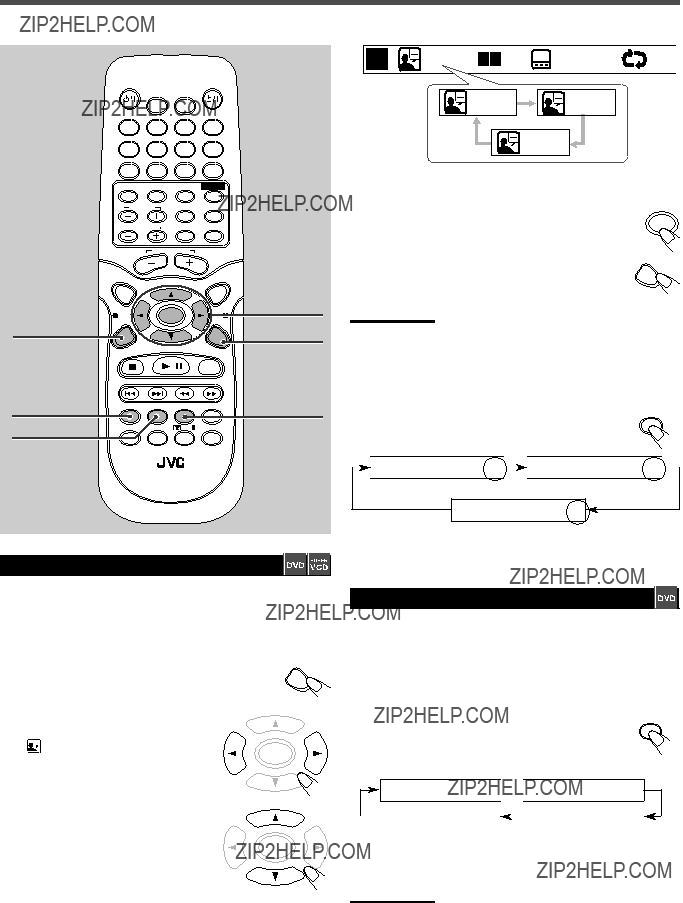
Disc Playback
Selecting the Audio Languages
While playing back a DVD/SVCD containing audio languages (sound track), you can select the language (sound track) to listen to.
???You can set your favorite audio language as the initial audio language (for DVD only). (See page 39.)
1 Press ON SCREEN.
The
2 Press 3/2 repeatedly to select
???  .???
.???
ENTER
The color of the icon changes when selected.
3Press 5/??? repeatedly to select the desired language.
ENTER
Ex.: When the DVD has 3 audio languages??? English (EN), French (FR), and Spanish (ES).
Notes:
Language names are not appear on the
back an SVCD.
To change the DVD audio language with one button
??? Each time you press the button, the audio language changes as follows:

 AUDIO: 2/3
AUDIO: 2/3 
 AUDIO: 3/3
AUDIO: 3/3 
AUDIO: 1/3
Ex.: When the DVD has 3 audio languages??? English (EN), French (FR), and Spanish (ES).
Selecting the Subtitles
While playing back a DVD containing subtitles in different languages, you can select the subtitle to be displayed on the TV screen.
???You can set your favorite subtitle language as the initial language shown on the screen. (See page 39.)
The
???Each time you press the button, the subtitle language changes as follows:
SUBTITLE 01/03 EN 
 SUBTITLE 02/03 FR
SUBTITLE 02/03 FR
Ex.: When the DVD has 3
Notes:
You can also change the subtitle by using the
22

Selecting the Playback Channel
When you play back a karaoke VCD/SVCD or CD, you can select the left channel or right channel to listen to.
???Each time you press the button, the sound mode changes as  follows:
follows:
STEREO
MONO LEFT: Select this to listen to the left channel sound.
MONO RIGHT: Select this to listen to the right channel sound.
STEREO: Select this to listen to both channel sounds.
REMEMBER to select ???STEREO??? to restore normal stereo playback after playing back a karaoke VCD/SVCD or CD using
???MONO LEFT??? or ???MONO RIGHT.???
Notes:
???You can also change the playback channel by using the
???This function does not work on a DTS CD though the mode indication appears and changes.
Selecting the
While playing back a DVD containing
???When you play back the DVD containing
From the remote control ONLY:
??? Each time you press the button, the view angle changes.
Ex.: When the disc has 3
Notes:
???You can also change the view angle by using the
???When the
 1/3
1/3 
 2/3
2/3
 3/3
3/3
???You cannot change the view angle in the chapter where does not appear even if the
does not appear even if the
Checking the Remaining Time 







While playing back a disc, you can check the remaining time to be played back.
From the remote control ONLY:
Press TIME.
The
???Each time you press the button, the following indication appears on the TV screen:
For DVD

 CHAPTER ELAPSED
CHAPTER ELAPSED 
 CHAPTER REMAIN
CHAPTER REMAIN
TITLE ELAPSED:
Select this to show the elapsed playing time of the current title.
TITLE REMAIN:
Select this to show the remaining time of the current title.
CHAPTER ELAPSED:
Select this to show the elapsed playing time of the current chapter.
CHAPTER REMAIN:
Select this to show the remaining time of the current chapter.
For VCD/SVCD/CD
TRACK ELAPSED:
Select this to show the elapsed playing time of the current track.
TRACK REMAIN:
Select this to show the remaining time of the current track.
TOTAL ELAPSED:
Select this to show the total elapsed playing time of the disc.
TOTAL REMAIN:
Select this to show the total remaining time of the disc.
23

Disc Playback
DVD CINEMA SYSTEM
Disc
For DVD
Disc
???When operating a DVD using the DVD menu, refer also to the instructions supplied for the DVD.
DVD generally have their own menus or title lists. A menu usually contains various information about the disc and playback selections. On the other hand, a title list usually contains titles of movies and songs recorded.
From the remote control ONLY:
MENU
1 Press MENU or TOP MENU.
A menu or title list will appear on the TV screen. ???MENU??? appears on the display.
TOP
??? On some DVDs, a menu will automatically appear MENU on the screen after playback starts.
2 Select a desired item on the menu or on the title list, using 3/2/5/???
For VCD/SVCD
Some VCDs and SVCDs have menus for interactive operations or a contents search function. The Play Back Control function (PBC) allows you to operate the VCD/SVCD using such menus.
When you start playing a VCD/SVCD with PBC function, a menu will automatically appear on the TV screen. (???MENU??? will also appear on the display.)
???Some VCDs or SVCDs with PBC function do not show menus automatically. This is due to their disc structures.
???A menu may be a list of items, divided screens, or some moving pictures. See ???PBC operation concept??? below.
When a menu appears, you can select a desired item on the menu.
???When a list of items is displayed on the TV screen, press the number buttons to select an item.
???When ???3??? or ???SELECT??? is displayed on the TV screen, press 3/8 to start playback.
To go to the next submenu
Press ??.
To return to the previous submenu
Press 4.
To cancel the PBC playback
You can cancel the
1Press 7 to stop playback.
2Press the number buttons to select a track, then press ENTER. Normal playback starts from the selected track.
PBC operation concept
Notes:
While operating a VCD/SVCD using menu, some of the functions
such as repeat play may not work.
and ENTER.
ENTER
The unit starts playback of the selected item.
???On some DVDs, you can also select items by pressing the number buttons corresponding to the item numbers listed.
24

Moving to a Particular Portion 






 Directly
Directly
You can move to another title, chapter, track, or particular portion in the chapter/title (DVD) or the disc (CD/VCD/SVCD) directly.
From the remote control ONLY:
1 Press ON SCREEN.
The
2 Press 3/2 to select one of the icons below.
ENTER
For DVD
 : Select this to move to another title.
: Select this to move to another title.

 : Select this to move to another chapter.
: Select this to move to another chapter.
 : Select this to move to a particular portion.
: Select this to move to a particular portion.
???You can input the chapter elapsed time when the
For VCD/SVCD/CD
 : Select this to move to another track.
: Select this to move to another track.
: Select this to move to a particular portion.
???You can only input the total elapsed time of the disc even if the track elapsed/remaining time is shown.
How to input the title, chapter and track number
Select the title/chapter/track number with the number buttons, then press ENTER to start playback.
???To select number 5, press 5.
???To select number 12, press 1, 2.
???To select number 22, press 2, 2.
About 3 seconds after you pressed number buttons, playback starts automatically from the selected title/chapter/track without pressing ENTER.
How to input the playing time
Press the number buttons to input the playing time, then press ENTER to start playback from the selected elapsed playing time.
???To input time ???00:45:23,??? press 4, 5, 2, 3.
???To input time ???01:23:45,??? press 1, 2, 3, 4, 5.
???To cancel a
Each time you press the button, the last entry will be erased.
About 3 seconds after you pressed number buttons, playback starts automatically from the selected time without pressing
ENTER.
Notes:
???You can also select a desired title, chapter or track by using 5/??? in step 3.
???You can move to another track directly by simply pressing the corresponding number buttons, then ENTER while playing back a CD/ VCD/SVCD (you can skip steps 1 and 2).
???Some DVDs reject the playing time input. This is due to their disc structures, and not a malfunction.
Searching for a Particular
Point
You can search for a particular point while playing a
???No sound comes out during Variable Speed Forward/Reverse Search except for CD
???Normal playback begins automatically when playback moves to the next or previous title/track.
To
From the remote control ONLY:
Press ?? during playback or pause.
???Each time you press the button, the search speed changes and is shown on the TV screen as follows:
 PLAY (Normal play)
PLAY (Normal play) 
 FF 32x
FF 32x 
 FF 8x
FF 8x
To reverse the
From the remote control ONLY:
Press 1 during playback or pause.
???Each time you press the button, the search speed changes and is shown on the TV screen as follows:

 FR (Fast Reverse)2x
FR (Fast Reverse)2x 

 FR 4x
FR 4x 
 PLAY (Normal play)
PLAY (Normal play) 
 FR 32x
FR 32x
 FR 8x
FR 8x 
To resume normal play
Press 3/8.
Notes:
The displayed search speed is an approximate value.
25
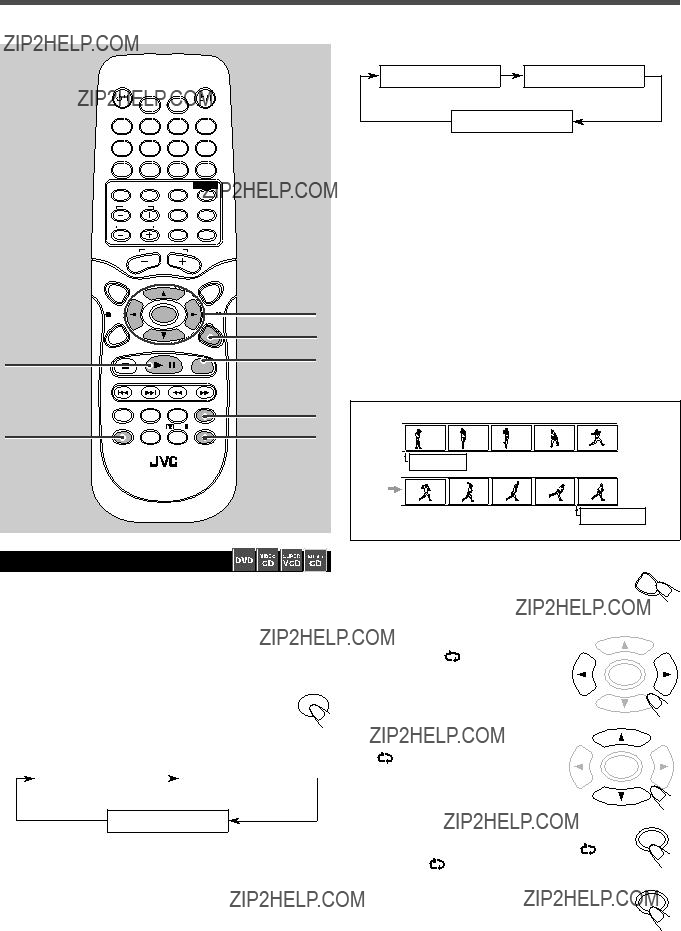
Disc Playback
ON SCREEN
Repeating Playback
During the VCD playback using the PBC function, you can only use the
For VCD/SVCD/CD
REPEAT:TRACKREPEAT:DISC
REPEAT:OFF
(REPEAT OFF)* * appearing on the display
REPEAT:TRACK: Current track will be repeated.
REPEAT:DISC: All the disc will be repeated.
REPEAT:OFF: Repeat play is canceled. (Normal play is resumed.)
To cancel Repeat Play
Press REPEAT repeatedly to select ???REPEAT:OFF.???
7
During playback, you can also select a portion you want to repeat.
???
???An interval of more than 5 seconds is required between point A and point B.
From the remote control ONLY:
1 Press ON SCREEN.
The
ON SCREEN
7 Repeat Play
From the remote control ONLY:
Press REPEAT repeatedly to select the repeat REPEAT mode. 
The repeat mode appears on the TV screen and the display. FM MOD
??? Each time you press the button, the repeat mode changes as follows:
For DVD
REPEAT:OFF
(REPEAT OFF)*
* appearing on the display
REPEAT:CHAPTER: Current chapter will be repeated.
REPEAT:TITLE: Current title will be repeated.
REPEAT:OFF: Repeat play is canceled. (Normal play is resumed.)
???REPEAT 

26

To cancel
Press 5/??? to select ??? OFF??? in step 3, then press ENTER.
OFF??? in step 3, then press ENTER.
???REPEAT
On some DVDs,
Special Picture Playback
7 Still
You can advance the motion picture frame by frame.
From the remote control ONLY:
7 Slow Motion Playback
You can enjoy slow motion playback while playing a DVD, VCD, or SVCD.
From the remote control ONLY:
For DVD:

 SF(Slow Forward) 1/2
SF(Slow Forward) 1/2 

 SF 1/4
SF 1/4 
 SF1/8
SF1/8 
PLAY (Normal play)

 SR 1/8
SR 1/8 
 SR1/4
SR1/4 
 SR(Slow Reverse)1/2
SR(Slow Reverse)1/2 

For SVCD/VCD:
 SF(Slow Forward) 1/2
SF(Slow Forward) 1/2 

 SF 1/4
SF 1/4 
 SF1/6
SF1/6 

PLAY (Normal play)
Notes:
Reverse slow playback does not work with SVCD/VCDs.
7 Zoom
You can zoom in on the picture while playing back a DVD, VCD, or SVCD.
From the remote control ONLY:
2 Press STEP repeatedly to advance the picture frame by frame.
STEP
???Each time you press the button, the picture advances frame by frame.
To resume normal play
Press 3/8.
3 Press ENTER.
appears, the magnification changes as follows:
+

???You can move the zoomed area with pressing 3/2/5/??? repeatedly.
To cancel the ZOOM
Press ZOOM again.
Notes:
You cannot zoom a JPEG picture.
27

MP3/JPEG Introduction
This system is incorporated with an MP3 decoder and JPEG decoder. You can play back MP3 tracks (files) and JPEG files recorded on
???Notice that ???files??? and ???tracks??? are used interchangeably in the MP3 explanation.
Notes:
This system can play back a disc containing both MP3 and JPEG
files.
What is MP3?
MP3 is an abbreviation of Motion Picture Experts Group (or MPEG) Audio Layer 3. MP3 is simply a file format with a data compression ratio of 1:10 (128 Kbps*). That means, by using MP3 format, one
*Bit rate is the average number of bits that one second of audio data will consume. The measuring unit used is Kbps (1000 bits per second).
To get a better audio quality, choose a higher bit rate. The most popular bit rate for encoding (recording) is 128 Kbps.
MP3 File Compatibility
???This system can only read MP3 files that are recorded in the format that is compliant with ISO 9660 Level 1 and Level 2, and Joliet.
???The system can read or play MP3 files only with the extension
Disc
???MP3 files (tracks)??? can be recorded in ???directories (or folders),??? in PC terminology.
During recording, the files and directories can be arranged in a way similar to arranging files and folder/directories of computer data. ???Root??? is similar to the root of a tree. Every file and directory can be linked to the root.
In compliance with ISO 9660, the maximum allowable depth of nested
Playback order, files search order, and directory search order of the MP3 files recorded on a disc are determined by the writing (or encoding) application; therefore, playback order may be different from the one you have intended while recording the folders/ directories and the files.
Note on MP3 discs
MP3 discs (either
What is JPEG?
A
Disc structure
On a JPEG disc, each still picture (material) is recorded as a file. Files are usually grouped into a folder. Folders can also include another folders, creating hierarchical folder layers.
???A maximum of 5 000 images can be stored on one CD.
???If there is any type of files other than JPEG files in a folder, those files are also counted in the total number of 5 000.
NOTES on JPEG discs
???JPEG discs (either
???When making a JPEG disc, select ISO 9660 Level 1, Level 2 or Joliet as the disc format.
???This system supports
???This system cannot play ???packet write??? discs.
???The system can read or play JPEG files only with the extension
???Some JPEG discs may not be played back because of their disc characteristics or recording conditions.
For
Playback Information on the display
File name
L R
SW
File No. Elapsed playing time
L R
JPEG SW
File No. Fixed to ???0: 00: 00???
L R
SW
File name
28

MP3/JPEG Playback
Starting Playback
It is recommended to turn on your TV when playing back MP3 or JPEG files.
Insert a disc.
After detecting the disc, playback starts automatically.
???The contents recorded on the disc are shown on the TV screen while playing back an MP3 file.
???JPEG files (still pictures) are automatically shown on TV screen one after another with the
???Press ON SCREEN to show the
???If the loaded disc is recorded in an unplayable format, ???WRONG DISC??? appears on the display. See also ???Disc
???The picture size of the JPEG file changes automatically to fit the TV screen.
???You cannot zoom a JPEG picture.
To go to another file
Press ?? or 4 during playback.
?????: Skip to the beginning of the next file.
???4: Skip to the beginning of the current or previous file.
Notes:
It requires a longer time to read out data when playback moves to files in another folder. It is not malfunction. The time varies with the number and type of files in the folder.
To stop playback for a moment
Press 3/8.
The picture stays on the TV screen when you play back a JPEG file.
To resume play, press 3/8 again or ENTER.
To stop during playback
Press 7.
??? The picture disappears and the
To remove the disc
Press 0.
???OPEN??? appears on the display and the disc tray comes out. 
To close the disc tray, press 0 again.
Showing the
You can show the following information on the TV screen while a disc is loaded.
From the remote control ONLY:
Press ON SCREEN.
??? Each time you press the button, the following
1: Current file and total number of the items in the current folder
??? Ex.: 1st file is playing out of 3 files in the current folder.
2: Time indicator
Each time you press TIME while playing back MP3 files, the indication changes between the elapsed playing time and the remaining time of the current file.
The indication is fixed ???0:00:00??? when a JPEG file is played back.
3: Repeat mode indicator
You can check the current repeat mode. The indication changes according to the repeat mode as follows:
See ???Repeating Playback??? on page 31 for the detail of each repeat mode.
29

MP3/JPEG Playback
 TVVOL
TVVOL TV/VIDEO MUTING
TV/VIDEO MUTING
5: Current file (Ex.: MP3 file)
To start playback of the selected file
Press 3/2/5/??? to select the file, then press
ENTER.
30
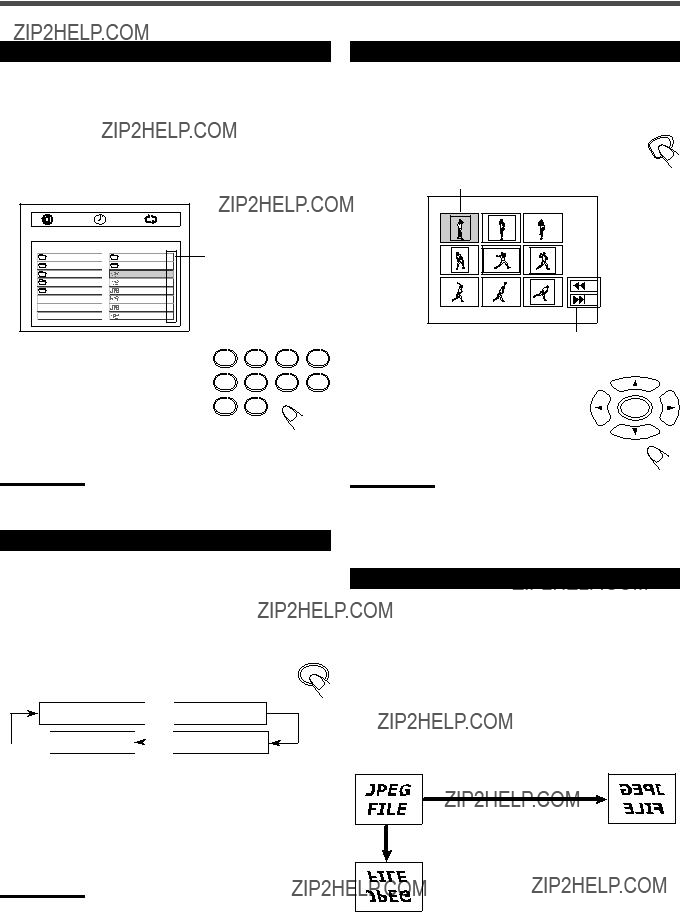
Selecting a Particular File/Folder Directly
You can move to a particular file/folder in the current folder directly.
From the remote control ONLY:
Press the number buttons to select a file/folder number (item number) you want, then press
ENTER.
The system starts playback from the selected file.
???To select number 23, press 2, 3, then
ENTER.
???To select number 123, press 1, 2, 3, then ENTER.
Notes:
When selecting the number of a folder, the contents of the folder appear on the content column.
Repeating Playback
To repeat
From the remote control ONLY:
REPEAT:TRACK 
 REPEAT:DIR
REPEAT:DIR
 REPEAT:OFF
REPEAT:OFF 
 REPEAT:DISC
REPEAT:DISC
REPEAT:TRACK: Current file will be repeated. The picture stand still when playing back a JPEG file.
REPEAT:DIR: Files in the current folder (directory) will be repeated.
REPEAT:DISC: All files on the disc will be repeated.
REPEAT:OFF: Repeat play is canceled. (Normal play is resumed.)
Notes:
You can check the repeat mode with
Browsing Pictures in the Current Folder
Selected picture
Select to go to the previous page (4) or the next page (??).
2 Press 3/2/5/??? to select the
Normal playback starts from the file you select.
Notes:
???The pictures appearing on the windows at first vary with the picture you have selected or played back before pressing MENU.
???It requires a longer time to show pictures on the windows. The time varies with the number and size of items in the current folder.
Rotating and Flipping a Picture
You can rotate/flip a picture during JPEG file playback.
JPEG file ONLY:
Press 3/2/5/???.
The picture rotates/flips each time you press the buttons.
3: Rotate the picture 90?? clockwise.
2: Rotate the picture 90??
5: Flip the picture vertically.
???: Flip the picture horizontally.
Ex.: Flipping a picture
Pressing ??? once
Pressing 5 once
31

Tuner Operations
For basic tuner operations, see ???Basic Tuner Operations??? on page 13.
Tuning in Stations
The last received station of the selected band is tuned in.
???Each time you press the button, the band alternates between FM and AM.
The system starts searching for stations and stops when a station of sufficient signal strength is tuned in.
???When you press the button repeatedly, the frequency changes step by step.
On the front panel:
1 Press SOURCE repeatedly until the desired SOURCE band appears on the display.
The last received station of the selected band is tuned in.
??? Each time you press the button, the source changes as follows:
 DVD/CD
DVD/CD  DIGITAL IN
DIGITAL IN
AM  FM
FM  AUX
AUX 
2 Press 7 so that ???MANUAL??? appears on the display.
???Each time you press the button, the operation mode of ?? and 4 buttons alternates between ???PRESET??? and ???MANUAL.???
PRESET: Select this for using ?? and 4 as the buttons to select the preset station.
MANUAL: Select this for using ?? and 4 as the buttons to change the frequency manually.
3 Press and hold ?? or 4.
??? ??: Increases the frequency.
??? 4: Decreases the frequency.
The system starts searching for stations and stops when a station of sufficient signal strength is tuned in.
???When you press the button repeatedly, the frequency changes step by step.
Notes:
???When a station of sufficient signal strength is tuned in, the
 indicator lights up on the display.
indicator lights up on the display.
???When an FM stereo program is received, the indicator also lights up.
indicator also lights up.
32
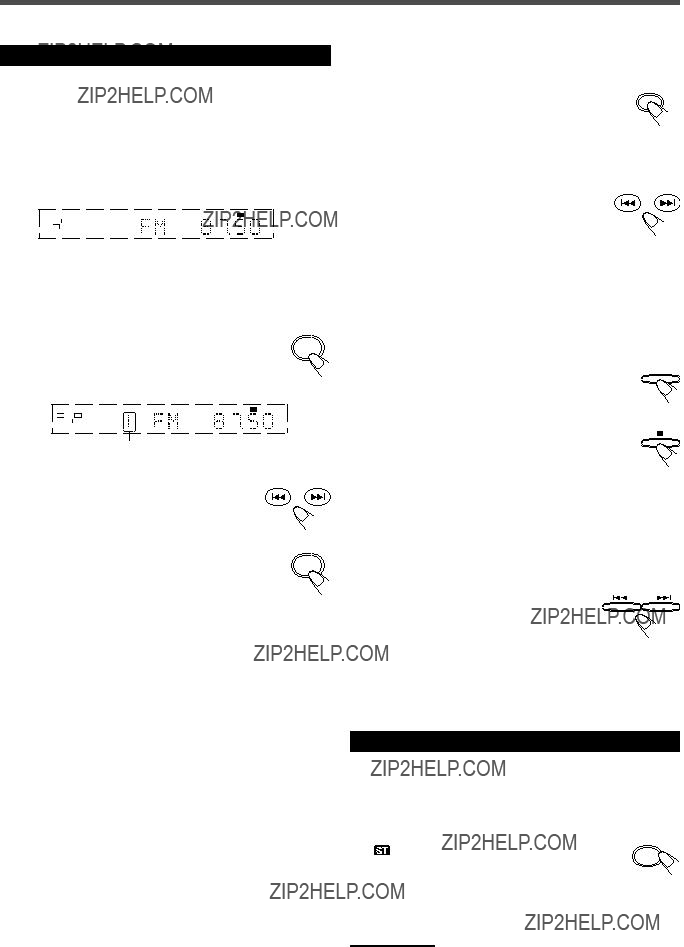
Using Preset Tuning
Once a station is assigned to a channel number, the station can be quickly tuned. You can preset up to 30 FM and 15 AM stations.
To store the preset stations
From the remote control ONLY:
1Tune in the station you want to preset (see ???Tuning in Stations???).
ST TUNED
L R
SW
MHz
There is a time limit in doing the following steps. If the setting is canceled before you finish, start from step 2 again.
2 Press MEMORY.
Preset number
3 Press ?? or 4 to select a preset number.
???Press and hold ?? or 4 to change the preset number continuously.
4 Press MEMORY to store the preset station.
To tune in a preset station
From the remote control:
The last received station of the selected band is tuned in.
???Each time you press the button, the band alternates between FM and AM.
2Press ?? or 4repeatedly until the desired preset station appears on the display.
?????: Increases the preset number.
???4: Decreases the preset number.
???Press and hold ?? or 4 to change the preset number continuously.
2 Press 7 so that ???PRESET??? appears on the display.
???Each time you press the button, the operation mode of ?? and 4 buttons alternates between ???PRESET??? and ???MANUAL.???
PRESET: Select this for using ?? and 4 as the buttons to select the preset station.
MANUAL: Select this for using ?? and 4 as the
The PRGM indicator goes off, and the station is assigned to the selected preset number.
MEMORY
buttons to change the frequency manually.
3 Press ?? or 4repeatedly until
5Repeat steps 1 to 4 until you store all the stations you want.
To erase a stored preset station
Storing a new station on a used number erases the previously stored one.
the desired preset station appears on the display.
?????: Increases the preset number.
???4: Decreases the preset number.
???Press and hold ?? or 4 to change the preset number continuously.
Selecting the FM Reception Mode
When an stereo FM program tuned currently is noisy, you can change the FM reception mode to improve the reception.
From the remote control ONLY:
program loses the stereo effect.
FM MODE
To resume the stereo effect, press FM MODE again.
The stereo effect resumes.
Notes:
Be sure to change the FM reception mode to stereo when you change
a station.
33

Tuner Operations
If the remote control is not for the tuner operations, the button for the RDS
INFO, and PTY
Using the RDS (Radio Data System)
to Receive FM Stations
RDS allows FM stations to send an additional signal along with their regular program signals. For example, the stations send their station names, as well as information about what type of program they broadcast, such as sports or music, etc.
When tuned to an FM station which provides the RDS service, the RDS indicator lights up on the display.
RDS indicator
Then, the display shows its PS name.
Notes:
???RDS is not available for AM broadcasts.
???RDS may not operate correctly if the tuned station is not transmitting RDS signals properly or if the signal strength is weak.
What information can RDS signals provide?
You can see the following RDS signals the station sends on the display.
PS NAME (Program Service):
While searching, ???PS NAME??? appears, then the station names will be displayed. ???NO PS??? appears if no signal is sent.
RT (Radio Text):
While searching, ???RT??? appears, then text messages the station sends will be displayed. ???NO RT??? appears if no signal is sent.
CT (Clock Time):
While searching, ???CT??? appears, then clock signals the station sends will be displayed. ???NO CT??? appears if no signal is sent.
Frequency:
Station frequency
From the remote control ONLY:
Make sure that the remote control is for the tuner operation. If not, press FM/AM on the remote control so that the remote control can be used for the tuner operation.
Press RDS while listening to an FM station to show the SLOW RDS signals. 
??? Each time you press the button, the display changes to RDS show the following information:
 PS NAME
PS NAME  RT
RT
Normal indication  CT
CT (Frequency)
(Frequency)
To check the PTY, press PTY SEARCH once so that the current PTY code appears. (See page 35.)
??? ???NO PTY??? appears if no signal is sent.
About characters shown on the display
When the display shows PS NAME, RT, or CT signals, the following characters are used.
???The display cannot differentiate upper case and lower case letters and always uses upper case letters.
???The display cannot show accented letters, ???A,??? for instance, may stand for accented ???A???s??? like ?????, ??, ??, ??, ??, ??, ??, ??, ??, ??, ??, and
??.???
Notes:
If searching finishes at once, ???PS NAME,??? ???RT,??? and ???CT??? will not appear on the display.
34
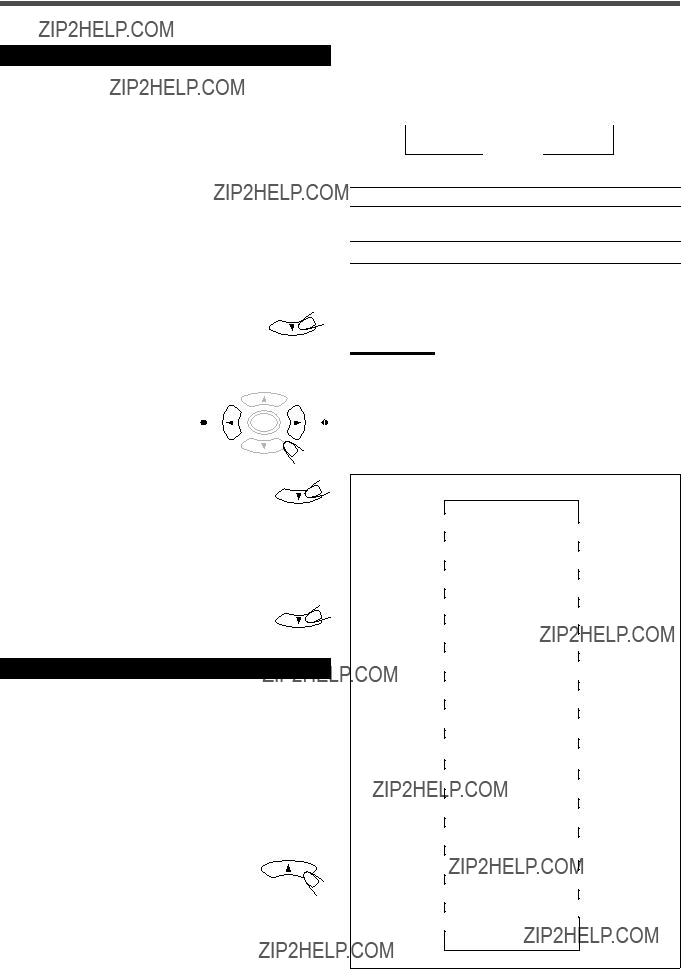
Searching for a Program by PTY Codes
One of the advantages of the RDS service is that you can locate a particular kind of program from the preset channels (see page 33) by specifying the PTY codes.
To search for a program using the PTY codes
Before you start, remember...
???The PTY Search is only applicable to preset stations.
???There is a time limit in doing the following steps. If the setting is canceled before you finish, start from step 1 again.
From the remote control ONLY:
Make sure that the remote control is for the tuner operation. If not, press FM/AM on the remote control so that the remote control can be used for the tuner operation.
1 Press PTY SEARCH while listening to
The currently selected PTY code appears on the display.
PTY codes??? on page 36.
2 Press PTY 9 or ( PTY to select the desired program.
Each time you press the button, the display changes to show the following.
 NEWS
NEWS
 INFO
INFO
 E. OFF
E. OFF
NEWS: News.
INFO: Program the purpose of which is to impart advice in the widest sense.
E. OFF: The search function is canceled.
The system starts to search FM stations automatically after you selected. When it finds the one you have selected, it tunes in that station.
Notes:
The search function is automatically canceled when you change the source or turn off the power.
3Press PTY SEARCH again, while the PTY code selected in the previous step is
The system searches FM preset stations, stops when it finds the one you have selected, and tunes in that station.
To stop during searching
Press PTY SEARCH again.
PTY SEARCH
Switching to a Selected Program
You can locate a particular kind of program from an FM RDS station.
From the remote control ONLY:
Make sure that the remote control is for the tuner operation. If not, press FM/AM on the remote control so that the remote control can be used for the tuner operation.
??? ???E. SELECT??? appears on the display.
PTY codes
DOCUMENT
NEWS
FOLK M (Music)
AFFAIRS
OLDIES
INFO (Information)
NATIONAL
SPORT
COUNTRY
EDUCATE (Education)
JAZZ
DRAMA
LEISURE
CULTURE
TRAVEL
SCIENCE
PHONE IN
VARIED
RELIGION
POP M (Music)
SOCIAL A
ROCK M (Music)
CHILDREN
EASY M (Music)
FINANCE
LIGHT M (Music)
WEATHER
CLASSICS
OTHER M (Music)
35
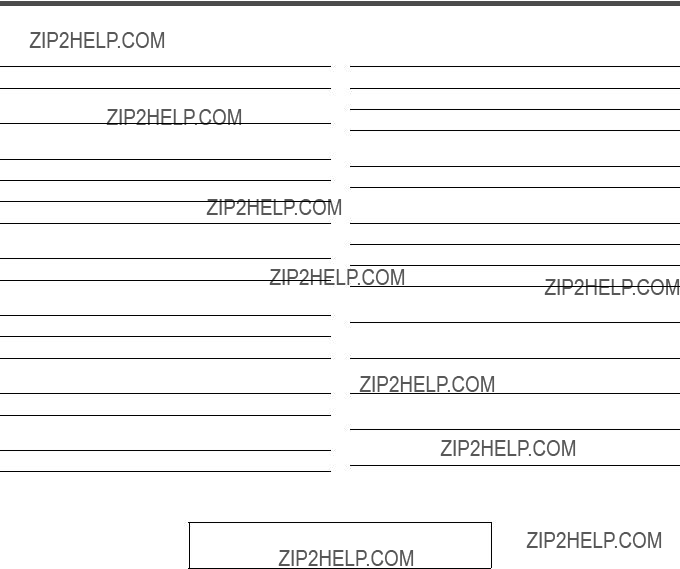
Tuner Operations
??? Description of the PTY codes:
NEWS: News.
AFFAIRS: Topical program expanding or enlarging upon the
INFO: Programs the purpose of which is to impart advice in the widest sense.
SPORT: Programs concerned with any aspect of sports.
EDUCATE: Educational programs.
DRAMA: All radio plays and serials.
CULTURE: Programs concerning any aspect of national or regional culture, including language, theater, etc.
SCIENCE: Programs about natural sciences and technology.
VARIED: Used for mainly
POP M: Commercial music of current popular appeal.
ROCK M: Rock music.
EASY M: Current contemporary music considered to be ???easy- listening.???
LIGHT M: Instrumental music, and vocal or choral works.
CLASSICS: Performances of major orchestral works, symphonies, chamber music, etc.
OTHER M: Music not fitting into any of the other categories.
WEATHER: Weather reports and forecasts.
FINANCE: Stock Market reports, commerce, trading etc.
CHILDREN: Programs targeted at a young audience.
SOCIAL A: Programs about sociology, history, geography, psychology and society.
RELIGION: Religious programs.
PHONE IN: Involving members of the public expressing their views either by phone or at a public forum.
TRAVEL: Travel information.
LEISURE: Programs about recreational activities.
COUNTRY: Songs which originate from, or continue the musical tradition of the American Southern States.
NATIONAL: Current popular music of the nation or region in that country???s language.
OLDIES: Music from the
FOLK M: Music which has its roots in the musical culture of a particular nation.
DOCUMENT: Programs concerning factual matters, presented in an investigative style.
Classification of the PTY codes for some FM stations may be different from the above list.
36

Setting Up the DVD Preferences
You can only use the remote control for the setup menu operations.
DVD CINEMA SYSTEM
On the setup menu, you can do the two main important settings??? system preference (GENERAL SETUP) menu and DVD preference (PREFERENCES) menu.
???Setup menu can only be displayed while a disc is not playing. (The DVD/CD must be selected as the source.)
Setting the System Preferences
You can set the system preferences to match it to your usage and operating circumstances.
On the general setting menu, you can set the following:
TV DISPLAY: Select the TV screen size for playing back a DVD recorded with 16:9 wide screen video signal.
??? WIDE: Select ???WIDE??? when the aspect ratio of the TV is
16:9. (Set the screen size to full on your TV.)
??? 4:3 LB: Select ???4:3 LB (Letter Box)??? when the aspect ratio of your TV is 4:3. While
viewing a wide screen picture,
the black bars appear on the top and the bottom of the screen.
??? 4:3 PS: Select ???4:3 PS
when the aspect ratio of your
TV is 4:3. While viewing a wide screen picture, the black bars do not appear, however,
the left and right edge sides of the pictures will not be shown on the screen.
OSD LANG (OSD language): Select the indication language shown on the TV screen while operating the system. (Ex. PLAY, STOP, PAUSE, etc.)
You can select the following languages: English, French, German, Italian, Spanish.
DRC (Dynamic Range Compression): You can enjoy a powerful sound at night even at a low volume when listening to the sound with Dolby Digital. The higher the tab is set, the deeper the effect become.
37

Setting Up the DVD Preferences
3 Press 5/??? to select (highlight) the menu item you want to adjust.
Select ???TV DISPLAY??? here. The sub menu for ???TV DISPLAY??? appears on the right column.
ENTER
???The basic procedure to set up the system preferences
Ex.: To select the TV screen size.
1 Press CHOICE.
The main page of the setup menu appears on the TV
SETUP MENU - - MAIN PAGE
2 Press ??? (or 5) to select (highlight)
4 Press 3.
The current setting on the sub menu is highlighted.
The selected setting is highlighted.
7Press 2 and repeat steps 3 to 6 to set up other items.
To return to the main page
Press 3/2/5/??? to select ???MAIN PAGE,??? then press ENTER.
To erase the setup menu
Press CHOICE.
??? To adjust the DRC (Dynamic Range Compression)
1Repeat steps 1 to 3 of ???The basic procedure to set up the system preferences??? to select
(highlight) ???DRC.???
The DRC adjustment tab appears on the right column.
???GENERAL SETUP,??? then press
ENTER.
ENTER
The general page appears on the TV screen. The general setup menu is shown on the left
column, and the sub menu for the selected (highlighted) item is shown on the right column.
Select to return to the main page.
2 Press 3.
???DRC??? gets dark and the adjustment tab becomes adjustable.
3 Press 5/??? to move the tab to the desired setting.
5: Increase the effect.
???: Decrease the effect.
To return to the main page
Press 3/2/5/??? to select ???MAIN PAGE,??? then press ENTER.
To erase the setup menu
Press CHOICE.
38

Setting the Preferences
You can select your favorite language to listen to or read on the TV screen. You can also restrict playback of DVDs containing violent scenes or those not suitable for your family members.
On the preferences menu, you can set the following:
??? The basic procedure to set up preferences
Ex.: To select the desired language as the initial language for ???AUDIO.???
1 Press CHOICE.
The main page of the setup menu appears on the TV CHOICE/TIME screen.
SETUP MENU - - MAIN PAGE
2Press ??? (or 5) to select (highlight) ???PREFERENCES,??? then press
ENTER.
ENTER
SUBTITLE:Select the subtitle language you read while watching a DVD.
DISC MENU:Select the menu language recorded on a DVD which you use while operating the DVD???s own menu.
PARENTAL:Select the restriction level of DVD playback (parental level).
???This setting takes effect only for the DVDs containing the rating level
PASSWORD:Change the password of PARENTAL.
The preferences page appears on the TV screen. The main menu of the preferences is
on the left column, and the sub menu for the selected (highlighted) item is shown on the right column.
3 Press 5/??? to select (highlight) the menu item you want to adjust.
ENTER
Select ???AUDIO??? in this case. The sub menu for ???AUDIO??? appears on the right column.
Languages you can select on this menu
You can select the following languages separately for ???AUDIO,??? ???SUBTITLE,??? and ???DISC MENU.???
English, Japanese, French, Spanish, Chinese, German, and
Italian*.
*You can set languages other than those above as the audio language or the subtitle language by selecting ???Others.??? See ???The basic procedure to set up preferences??? below for the detail.
Notes:
The original language will be selected as the initial language regardless of your setting in the following cases:
???If the language you have selected is not recorded on the disc.
???If the disc is programmed to be played back in the original language.
4 Press 3.
The current setting on the sub menu is highlighted.
5 Press 5/??? to select the desired setting.
Select the audio language in this case.
The selected language is highlighted.
???When you select ???OTHERS,??? the ???INPUT
LANGUAGE CODE??? page appears. Press the number buttons to enter the code (4 digits) of the language you want to set, then press ENTER. The language code list is on page 41.
7Press 2 and repeat steps 3 to 6 to set up other items.
To return to the main page
Press 3/2/5/??? to select ???MAIN PAGE,??? then press ENTER.
To erase the setup menu
Press CHOICE.
39
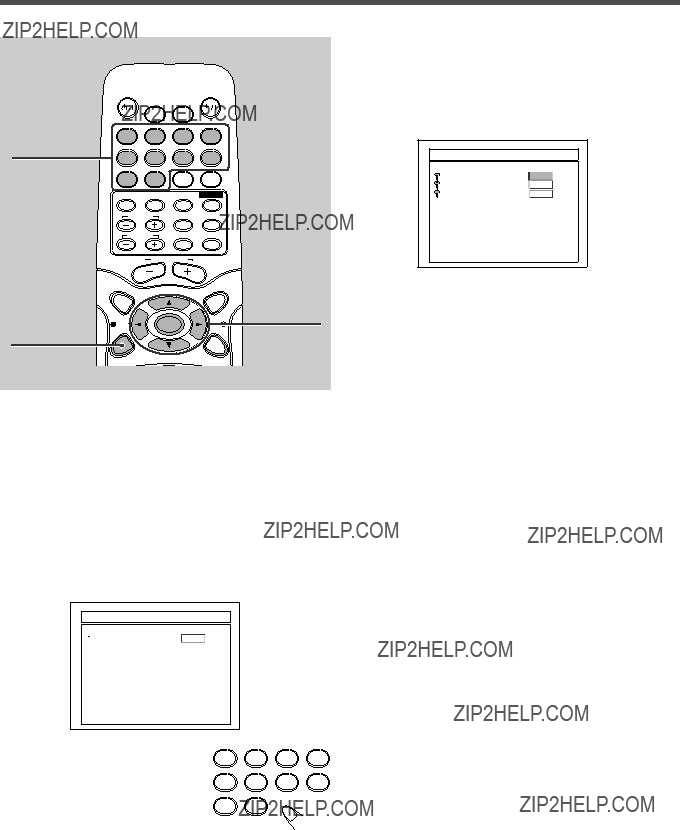
Setting Up the DVD Preferences
??? To set the parental (rating) level
Using this function, you can restrict playback of DVD containing violent scenes and those not suitable for your family members. Nobody can play such a disc unless this function is canceled.
???This setting takes effect only for the DVDs containing the rating level
1Repeat steps 1 to 5 of ???The basic procedure to set up preferences??? to select the desired parental
level, then press ENTER.
The ???PASSWORD VERIFY PAGE??? appears.
PASSWORD VERIFY PAGE
 INPUT PASSWORD:
INPUT PASSWORD:
??? When shipped from the factory, the password is ???7890.???
To clear the password entry, press ENTER.
You can enter the password again from the first digit.
???A wrong password is automatically cleared after entering the last digit.
To erase the setup menu
Press CHOICE.
??? To change the password
1Repeat steps 1 to 5 of ???The basic procedure to set up preferences??? to select ???CHANGE??? then
press ENTER.
The ???PASSWORD CHANGE PAGE??? appears.
2Press the number button to enter the current password (4 digits) in the ???OLD PASSWORD???
box.
Four asterisks appear in the box after entering the right password.
??? When shipped from the factory, the password is ???7890.???
To clear the password entry, press ENTER.
You can enter the password again from the first digit.
???A wrong password is automatically cleared after entering the last digit.
3Press the number button to enter the new password (4 digits) in the ???NEW PASSWORD???
box.
Four asterisks appear in the box after entering the new password.
4Press the number button to enter the new password (4 digits) again in the ???CONFIRM
PWD??? box to verify the password.
Four asterisks appear in the box after entering the right new password.
???Both ???NEW PASSWORD??? box and ???CONFIRM PWD??? box are cleared when you enter a wrong password. Start from step 3 again in that case.
???You cannot cancel the password change after step 4. Repeat steps 1 to 4 to change the password again to restore the old password.
To erase the setup menu
Press CHOICE.
40

7 To release the parental lock temporarily
When you set a strict parental level, some discs may not be played back at all.
If you try to playback such a disc, you need to input the password to release parental lock temporarily (???INPUT PASSWD:??? appears on the TV.) You cannot play the disc before you enter the correct password.
When you enter a wrong password, ???PASSWD WRONG??? appears on the TV and playback is refused.
??? Language Code List
7 To reset the password to the initial setting
When you forget the password, you can restore the password to the initial setting (7890).
On the front panel ONLY:
1Press SOURCE to select ???DVD/CD??? as the source when the center unit has no disc.
???NO DISC??? appears on the display.
2Press and hold 7 for more than 5 seconds.
???INITIAL??? appears on the display and the password is restored to the initial setting, 7890.
???This operation erases all the stored settings. Do not carry out this without necessity.
41

Operating TV
You can use the remote control to operate not only this unit but also JVC???s TV.
???Refer also to the manuals supplied for the other products.
???To operate the other products, aim the remote control directly at the remote sensor on the target product.
???To operate a JVC???s TV
You can perform the following operations on the TV.
DVD CINEMA SYSTEM
After pressing CONTROL TV on the remote control, CONTROL
???For some TVs, MEMORY works to change the channel digit between one digit and two digits.
IMPORTANT:
When you press CONTROL TV, some buttons on the remote control cannot work for operating the system.
To operate the system, press DVD, FM/AM, or AUX.
42

Maintenance
To get the best performance of the unit, keep your discs and mechanism clean.
General Notes
In general, you will have the best performance by keeping your discs, and the mechanism clean.
???Store discs in their cases, and keep them in cabinets or on shelves.
???Keep the disc tray closed when not in use.
Handling Discs
??? Remove the disc from its case by holding it at the edge while pressing the center hole lightly.
??? Do not touch the shiny surface of the disc, or bend the disc.
???Put the disc back in its case after use to prevent warping.
??? Be careful not to scratch the surface of the disc when placing it back in its case.
???Avoid exposure to direct sunlight, temperature extremes, and moisture.
Cleaning the unit
???Stains on the unit
Should be wiped off with a soft cloth. If the system is heavily stained, wipe it with a cloth soaked in
???Since the system may deteriorate in quality, become damaged or get its paint peeled off, be careful about the following.
???DO NOT wipe it with a hard cloth.
???DO NOT wipe it strong.
???DO NOT wipe it with thinner or benzine.
???DO NOT apply any volatile substance such as insecticides to it.
???DO NOT allow any rubber or plastic to remain in contact with it for a long time.
To clean the disc
Wipe the disc with a soft cloth in a straight line from center to edge.
DO NOT use any
43

Troubleshooting
Use this chart to help you solve daily operational problems. If there is any problem you cannot solve, contact your JVC service center.
PROBLEM
Power does not come on.
The remote control does not work.
POSSIBLE CAUSE
The power cord is not plugged in.
???It is too far from the center unit, or is not facing the center unit.
???There is something obstructing the remote sensor.
???The CONTROL TV button has been pressed.
???The battery is flat.
???The battery has been inserted the wrong way round
???Sunlight is falling directly on the detector.
SOLUTION
Insert the plug into the socket.
???Come close to the center unit.
???Avoid any obstacles.
???Press DVD, FM/AM, or AUX to operate the system. (See page 42.)
???Replace the battery.
???Insert the battery correctly.
???Shade the remote control from direct sunlight.
No sound.
Sound is emitted from only one speaker.
No video.
A disc cannot be played.
???There is a short in the speaker cord.
???The audio cord is not connected properly.
???An incorrect source has been selected.
???Muting is on.
???The speaker cord is not connected correctly.
???
???The video cord is not connected properly.
???TV input selection is incorrect.
???The system and disc region code numbers are incompatible.
???The disc causes the parental (rating) error.
???Reconnect the speaker cord.
???Connect the cord properly. (See page 9.)
???Select the correct source. (See pages 10 to 14.)
???Press MUTING to cancel muting.
???Connect the cord properly. (See page 7.)
???Adjust balance. (See page 15.)
???Connect the cord properly. (See page 8.)
???Select the correct input.
???Replace the disc. (See page 19.)
???Enter password to change the parental (rating) level. (See page 40.)
???WRONG DISC??? appears on the display.
???NO DISC??? appears on the display though a disc is inserted.
Video and audio are distorted.
The edge is missing on the video image.
???A VCR is connected between the center unit ??? Connect the center unit and TV directly. and the TV.
Continuous static during FM broadcasts.
The system does not work correctly.
???The received signal is too weak.
???The station is too far away.
???The antenna is not connected correctly.
???Lightning or electronic noise interferes with operation of the microcomputer.
???Immediately after beginning to heat the room, the unit was moved to a cold location causing condensation to form inside.
???Connect an external FM antenna (see page 5), or contact your dealer.
???Select another station.
???Check the connection. (See page 5.)
???Switch power off, and remove and
When the system is not restored with the operation above, switch power off and press and hold 7 on the main unit for 5 seconds. The STANDBY lamp goes off for a moment and the microcomputer is reset*.
*This operation erases all the stored settings. Do not carry out this without necessity.
???Switch power off and leave the unit a few hours before switching power on again.
44

Specifications
Center unit
Amplifier section
Front/Center/Rear:
30 W per channel, min. RMS at 6 ??? as 1 kHz, with no more than 10% total harmonic distortion
Subwoofer:
55 W, min. RMS at 3 ??? as 100 Hz,
with no more than 10% total harmonic distortion
Audio section
Audio input sensitivity/Impedance (at 1 kHz)
Analog input:
AUX (???AUDIO IN???): 500 mV/47 k???
Digital input*:
DIGITAL IN (OPTICAL):
* Corresponding to Linear PCM, Dolby Digital, and DTS Digital Surround (with sampling
Video section
Horizontal Resolution: 480 lines
Output Level
VIDEO(Composite): 1.0
RGB: (R): 0.7
(G): 0.7
(B): 0.7
Designs & specifications are subject to change without notice.
45

SYSTEM CINEMA DIGITAL DVD
VICTOR COMPANY OF JAPAN, LIMITED